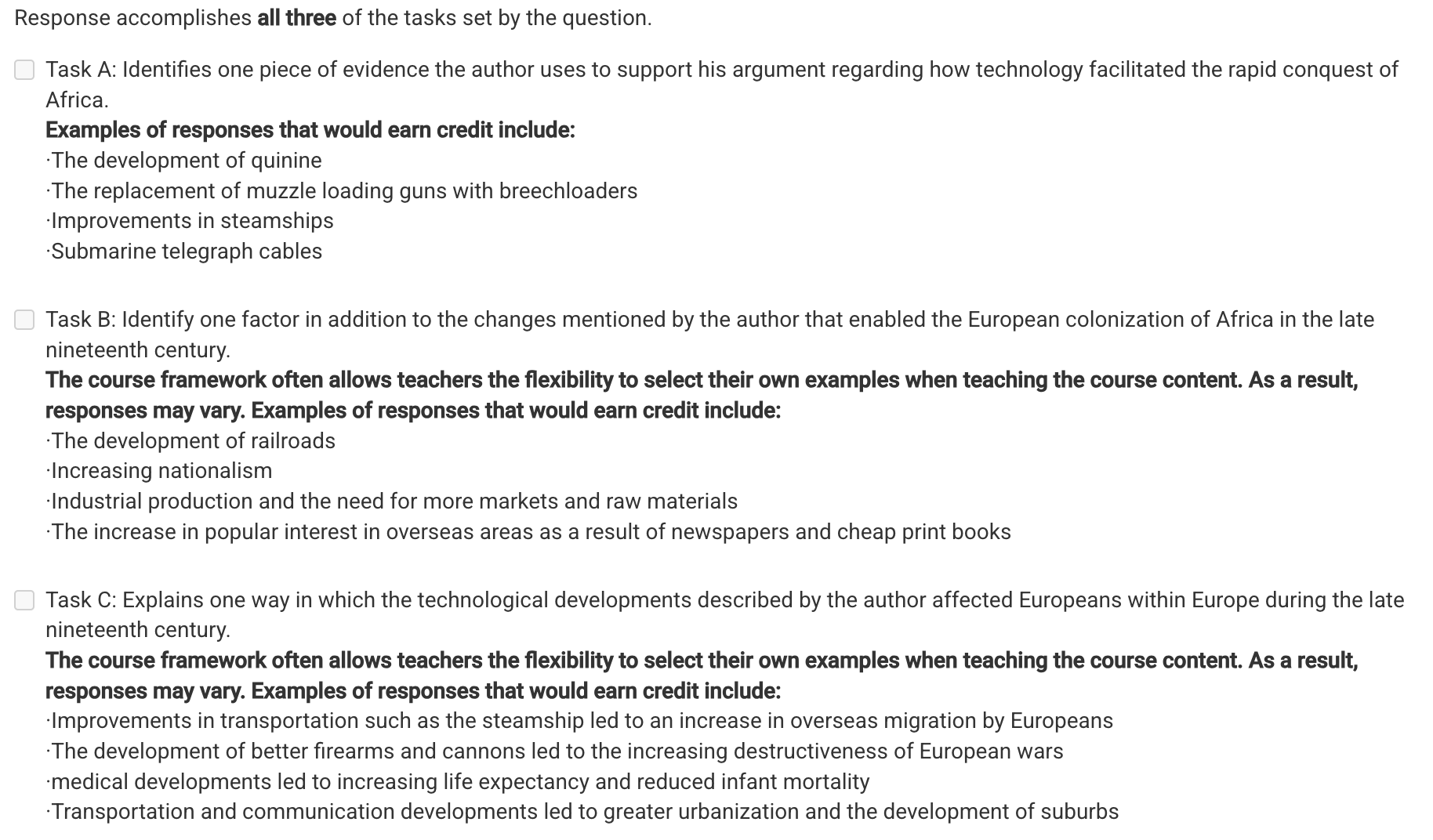AP EURO Unit 7
1/32
Earn XP
Description and Tags
Taken from CollegeBoard
Name | Mastery | Learn | Test | Matching | Spaced |
|---|
No study sessions yet.
33 Terms
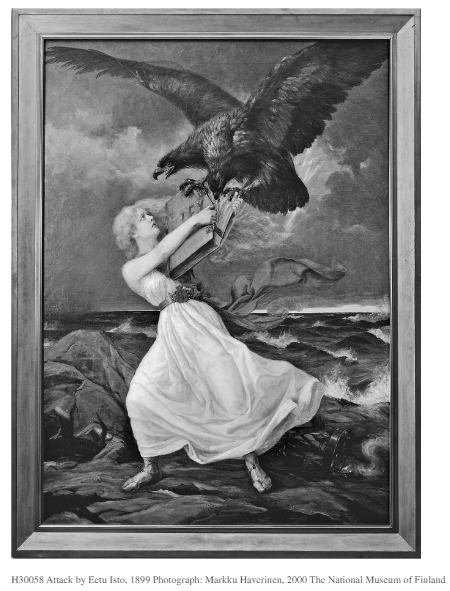
The painting shows a young woman holding a book of laws, representing Finland, being attacked by a double-headed eagle, symbolizing imperial Russia. The painting was created in reaction to Russian policies limiting Finnish autonomy within the Russian Empire and starting a process of cultural Russification in Finland.
Based on the painting, it can be inferred that Isto was most likely inspired by which of the following?
A) Romanticism, which used strong emotions to foster a sense of shared local or national group identity
B) Realism, which depicted ordinary people’s lives to draw attention to pressing social problems
C) Surrealism, which used depictions of dreams and visions to emphasize the newly discovered importance of irrational and subconscious motivations for human behavior
D) Primitivism, which adopted styles and subject matter derived from imperial encounters to open debates about European acquisition of colonies
A) Romanticism, which used strong emotions to foster a sense of shared local or national group identity
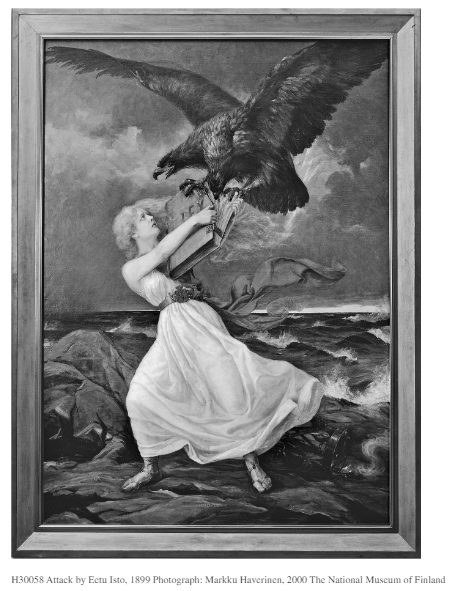
The painting shows a young woman holding a book of laws, representing Finland, being attacked by a double-headed eagle, symbolizing imperial Russia. The painting was created in reaction to Russian policies limiting Finnish autonomy within the Russian Empire and starting a process of cultural Russification in Finland.
Imperial reform efforts in nineteenth-century Russia had which of the following effects?
A) The reforms enabled Russia to catch up with western Europe economically, by abolishing serfdom and other primitive practices.
B) The reforms had the unintended effect of giving rise to radical revolutionary movements, which led to the Russian Revolution of 1905.
C) The reforms succeeded in reducing ethnic tensions in the Russian Empire but did little to address Russia’s economic backwardness.
D) The reforms served as a model for the Soviet industrialization and collectivization campaigns of the 1920s and 1930s.
B) The reforms had the unintended effect of giving rise to radical revolutionary movements, which led to the Russian Revolution of 1905.
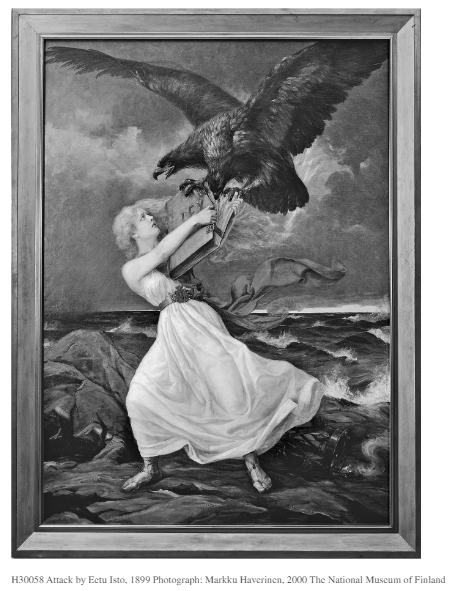
The painting shows a young woman holding a book of laws, representing Finland, being attacked by a double-headed eagle, symbolizing imperial Russia. The painting was created in reaction to Russian policies limiting Finnish autonomy within the Russian Empire and starting a process of cultural Russification in Finland.
At the time the painting was produced, the style and subject of artworks such as Isto’s Attack were being challenged by a new group of European artists who argued that modern art should
A) return to its Renaissance and Neoclassical roots
B) move beyond the representational and toward the abstract
C) place itself in the service of the state’s propaganda needs
D) use mass-market imagery to comment on consumer society
B) move beyond the representational and toward the abstract
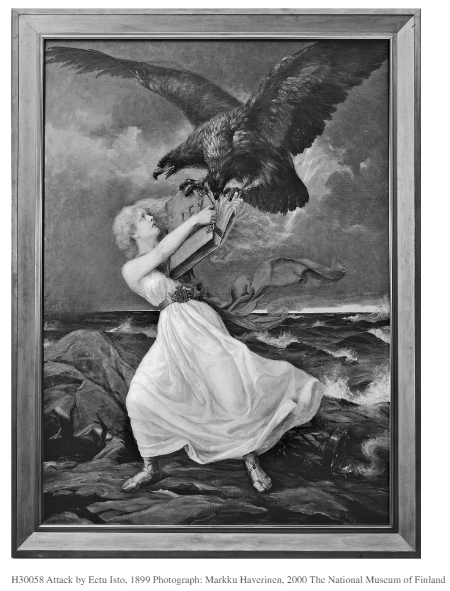
The painting shows a young woman holding a book of laws, representing Finland, being attacked by a double-headed eagle, symbolizing imperial Russia. The painting was created in reaction to Russian policies limiting Finnish autonomy within the Russian Empire and starting a process of cultural Russification in Finland.
Based on your knowledge of nineteenth-century European history, which of the following best explains the use of gendered symbols such as the one seen in Isto’s painting?
A) Bourgeois norms portrayed women as vulnerable and in need of men’s protection.
B) Feminists successfully argued for greater legal and social equality for women.
C) Industrialization threatened traditional notions of femininity.
D) Conservative policies in Restoration Europe limited women’s ability to participate in revolutionary activities.
A) Bourgeois norms portrayed women as vulnerable and in need of men’s protection.
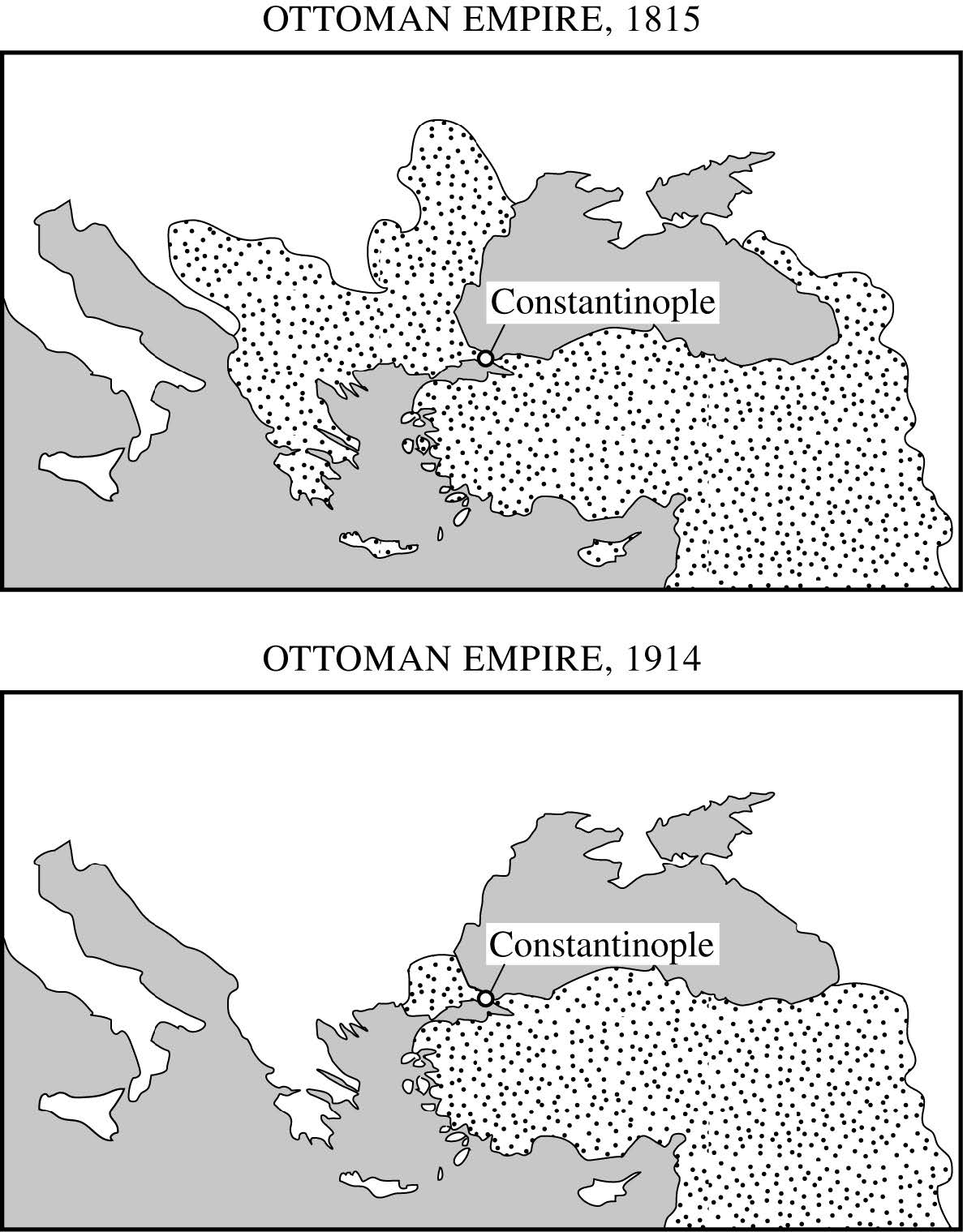
The changes shown on the maps contributed most directly to
A) the destabilization of the European balance of power
B) the dissolution of Austria-Hungary
C) the modernization of the Russian Empire
D) the greater integration of Eastern Europe into the global trade system
B) the dissolution of Austria-Hungary
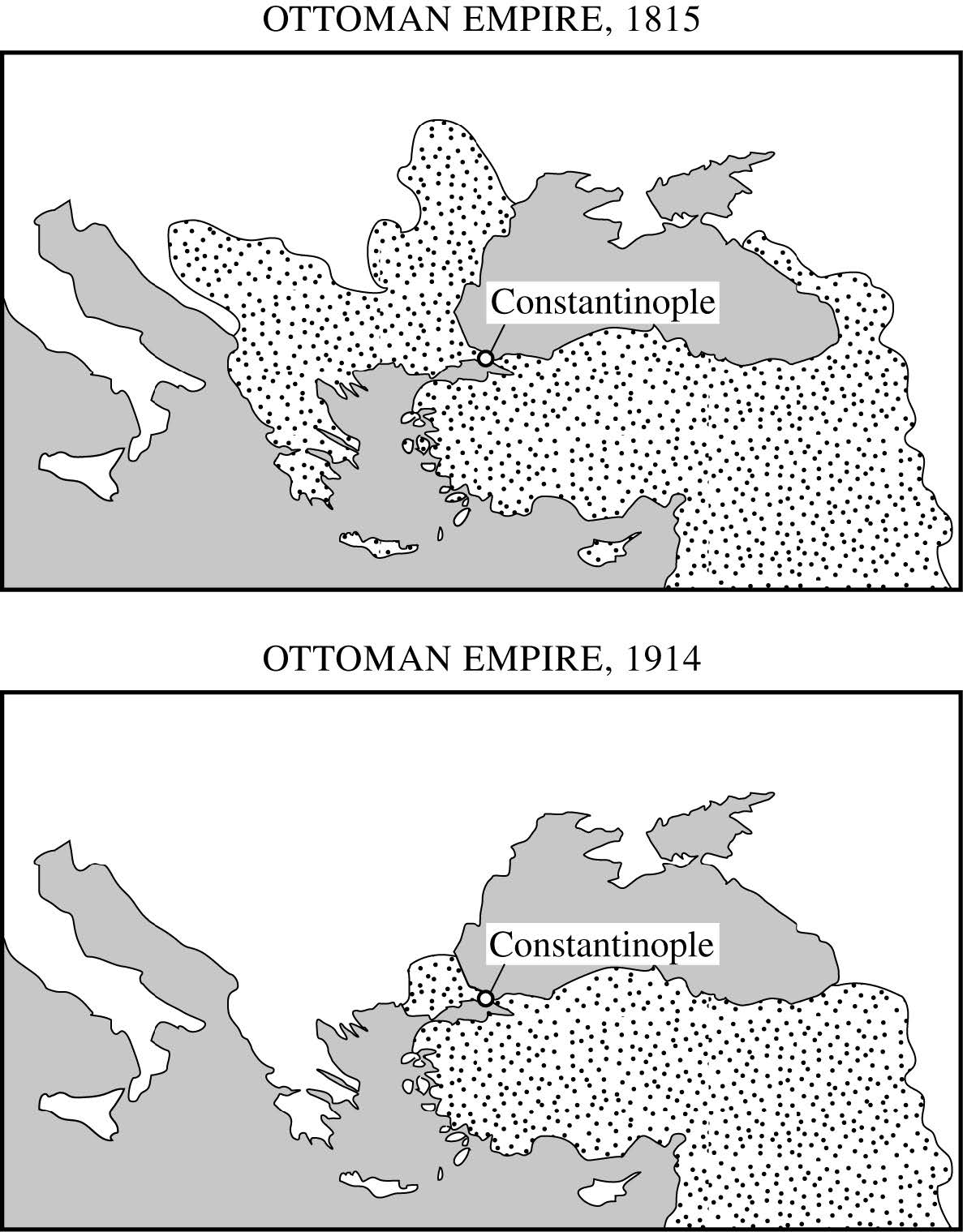
Which of the following was the most significant factor that contributed to the changes to Ottoman territory shown on the maps?
A) Western European efforts to halt the spread of Islam in Europe
B) The spread of nationalism in the Balkans
C) The economic and social disruptions caused by the industrialization of the Ottoman Empire
D) The defeat of Napoleon by a coalition of conservative monarchies
B) The spread of nationalism in the Balkans
In the period 1815–1914, which of the following regions of Europe experienced political developments that most strongly contrasted with those shown on the maps?
A) Spain
B) The British Isles
C) France
D) The Italian Peninsula
D) The Italian Peninsula
“Serbia will someday set Europe by the ears and bring about a universal war on the Continent. I cannot tell you how exasperated people are getting here at the continual worry which that little country causes to Austria under encouragement from Russia. It will be lucky if Europe succeeds in avoiding war as a result of the present crisis.”
Sir Fairfax Cartwright, British ambassador to Austria-Hungary, memo to the British Foreign Office, 1913
The instability that Cartwright attributes to Serbia’s actions is best explained by which of the following?
A) Socialist uprisings against capitalist regimes
B) Colonial independence movements that challenged European domination
C) Nationalist agitation that threatened multiethnic empires
D) Diplomatic efforts to dismantle national governments in favor of a unified Europe
C) Nationalist agitation that threatened multiethnic empires
“Serbia will someday set Europe by the ears and bring about a universal war on the Continent. I cannot tell you how exasperated people are getting here at the continual worry which that little country causes to Austria under encouragement from Russia. It will be lucky if Europe succeeds in avoiding war as a result of the present crisis.”
Sir Fairfax Cartwright, British ambassador to Austria-Hungary, memo to the British Foreign Office, 1913
The willingness of Russia to support Serbia, as mentioned by Cartwright, is best explained by which of the following?
A) Development of an increasingly rigid system of alliances involving all major European powers
B) Attempts to unite all Slavic peoples into a single nation-state
C) Initiatives to create an effective international disarmament treaty
D) Efforts to block British influence in the Balkans
A) Development of an increasingly rigid system of alliances involving all major European powers
“Serbia will someday set Europe by the ears and bring about a universal war on the Continent. I cannot tell you how exasperated people are getting here at the continual worry which that little country causes to Austria under encouragement from Russia. It will be lucky if Europe succeeds in avoiding war as a result of the present crisis.”
Sir Fairfax Cartwright, British ambassador to Austria-Hungary, memo to the British Foreign Office, 1913
The tensions between Russia and Austria-Hungary alluded to by Cartwright were most strongly exacerbated by which of the following?
A) Ideological differences between the two countries’ regimes
B) Competition for overseas colonies
C) A major arms buildup
D) Austrian efforts to provoke nationalist unrest among Russia’s ethnic minorities
C) A major arms buildup
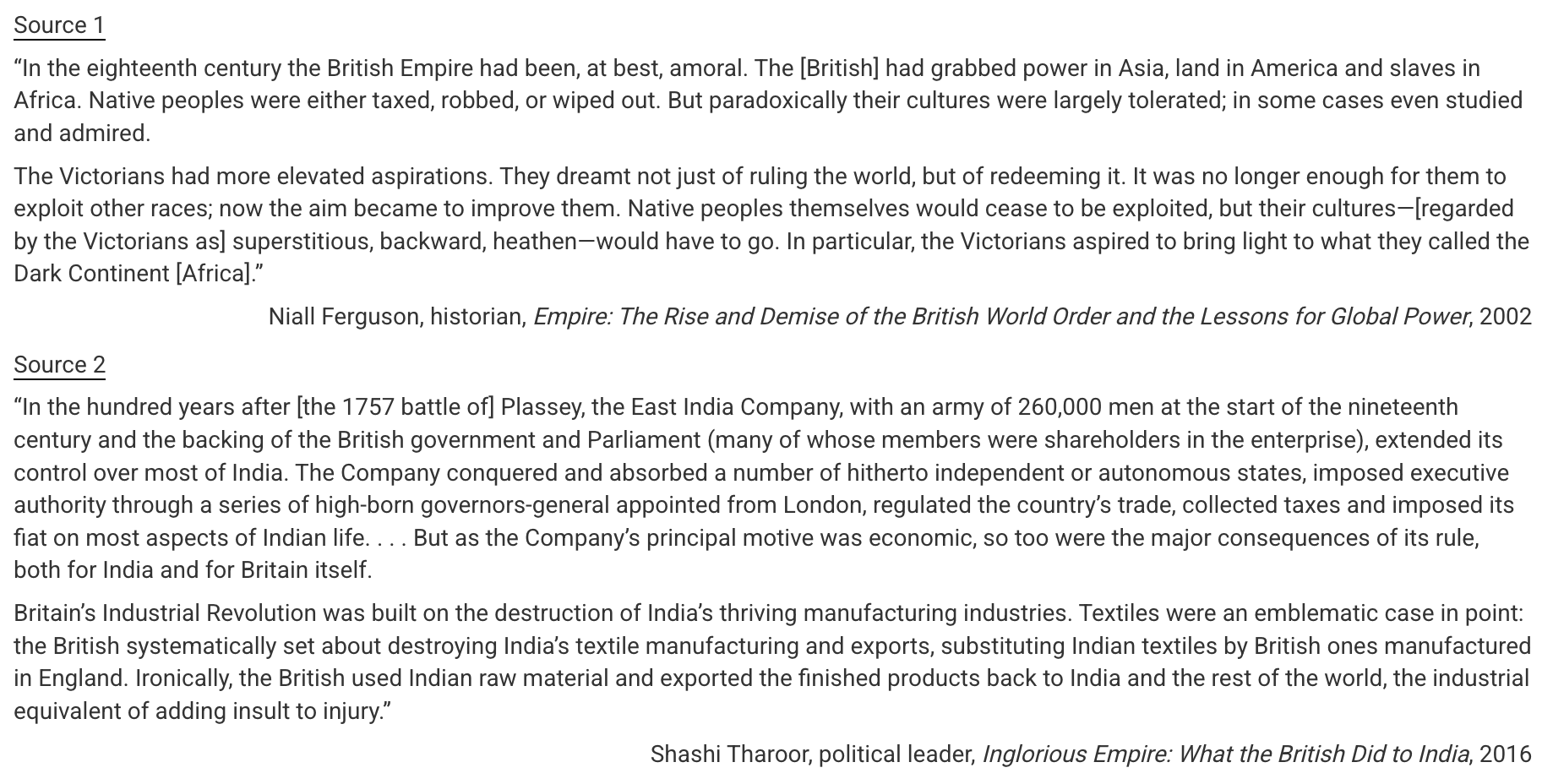
The British actions described in the passages best explain which of the following reactions in the late nineteenth century?
A) Rival European states, such as France and Germany, sought to draw Britain into alliance structures in order to minimize conflict over overseas empires.
B) British colonial subjects who received a western education created nationalistic movements to resist imperialism.
C) Many European countries began to lower trade barriers in order to take advantage of British colonial imports.
D) European states created state-run trading companies to manage profits from colonial exports.
B) British colonial subjects who received a western education created nationalistic movements to resist imperialism.

The policies described in the second paragraph of Source 2 are most closely related to which of the following economic systems?
A) Marxism, which saw the destructive aspects of industrialization as leading to the unavoidable overthrow of capitalism
B) Mercantilism, which sought to maximize the home country’s positive balance of trade
C) Laissez-faire liberalism, which aimed for goods to be produced in the regions where they could be created most cheaply and efficiently
D) Utopian socialism, which tried to replace capitalist control over industry with local, cooperative ownership
B) Mercantilism, which sought to maximize the home country’s positive balance of trade
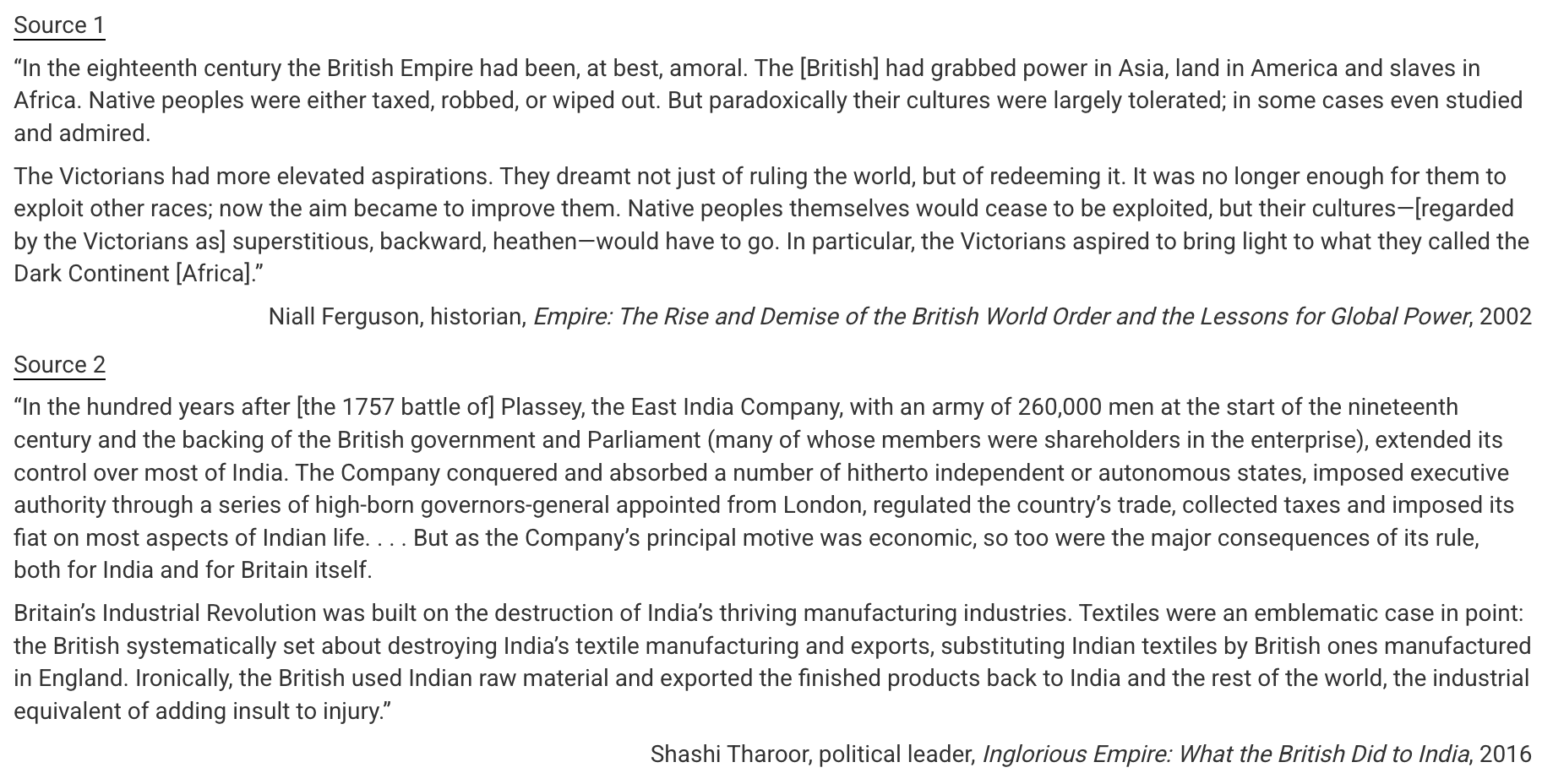
The Victorian shift in attitudes toward Africa described by Ferguson in Source 1 was most strongly connected to which nineteenth-century development?
A) The growth of domestic social reform movements in Britain
B) The increased demand for African raw materials such as rubber
C) The incorporation of African themes and motifs into European art
D) The defeat of France in the Napoleonic Wars and the effective end of colonial competition with France in much of the world
A) The growth of domestic social reform movements in Britain

Dreadnoughts were a new type of battleship. John Bull was a popular personification of Great Britain.
Which of the following was the most significant factor contributing to the rivalry depicted in the cartoon?
A) British and German competition for influence in the Balkans
B) Britain’s economic reliance on an overseas colonial empire
C) Efforts by the British government to prevent the unification of Germany
D) Agitation by German and British industrial workers trying to maintain high levels of employment
B) Britain’s economic reliance on an overseas colonial empire
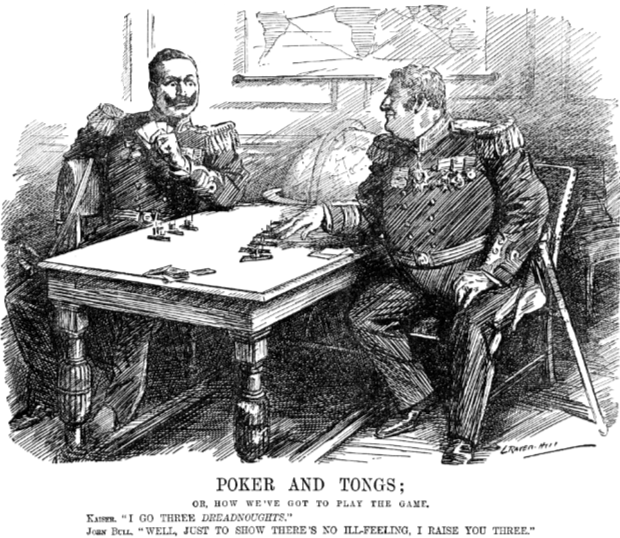
Dreadnoughts were a new type of battleship. John Bull was a popular personification of Great Britain.
The rivalry depicted in the cartoon had which of the following effects on European politics in the period before the First World War?
A) It undermined Germany’s efforts to isolate France diplomatically.
B) It spurred widespread support for international disarmament.
C) It triggered political crises in Germany and Britain caused by resistance to high levels of military spending.
D) It encouraged other European powers to attempt to match the size of the British navy.
A) It undermined Germany’s efforts to isolate France diplomatically.
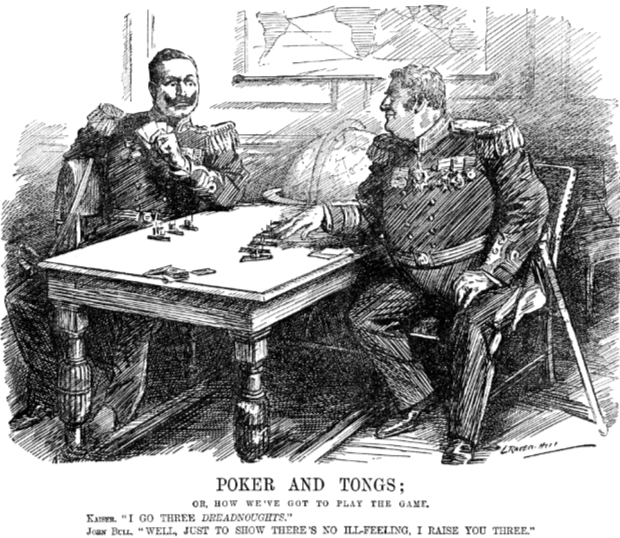
Dreadnoughts were a new type of battleship. John Bull was a popular personification of Great Britain.
Which of the following best describes the intended purpose of the cartoon?
A) To argue for the desirability of more naval cooperation between Britain and Germany
B) To criticize the insular culture of British and German naval officers
C) To portray the British naval buildup as a justifiable reaction to a German threat
D) To criticize the aristocratic dominance of the British and German officer corps
C) To portray the British naval buildup as a justifiable reaction to a German threat
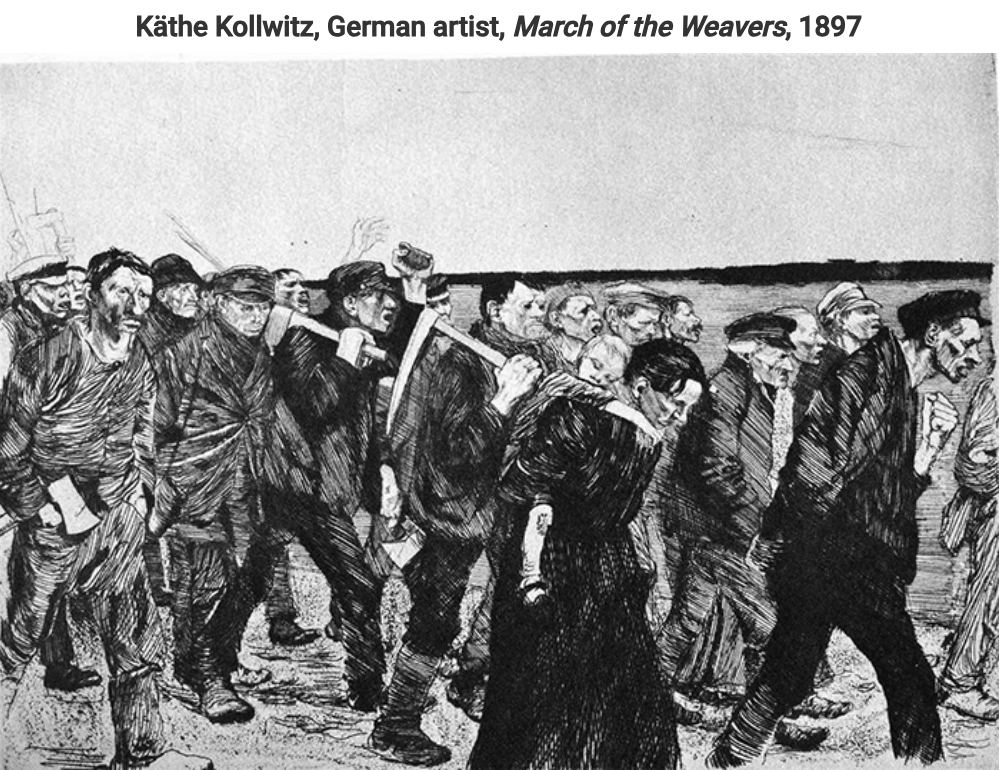
Kollwitz produced this engraving after watching a play about a famous strike by German weavers in the 1840s
Kollwitz’ portrayal of the weavers is best explained as an attempt to
A) inspire the authorities to repress social unrest
B) warn working people against the dangers of socialism
C) sympathetically depict ordinary people affected by social problems
D) instill the sufferings of common people with religious meaning
C) sympathetically depict ordinary people affected by social problems

Kollwitz produced this engraving after watching a play about a famous strike by German weavers in the 1840s
The condition of the workers and their families as portrayed by Kollwitz is best explained in the context of which of the following?
A) The failure of Germany to industrialize at the same time as Great Britain
B) Industrial boom and bust cycles and the lack of an effective social safety net
C) The abolition of serfdom in Prussia and the end of feudal obligations
D) Shortages of skilled labor for newly mechanized industries such as textiles
B) Industrial boom and bust cycles and the lack of an effective social safety net

Kollwitz produced this engraving after watching a play about a famous strike by German weavers in the 1840s
Kollwitz’ depiction of workers and their families is best explained as a rejection of
A) the Romantic emphasis on heightened emotion and individualism
B) naturalistic depictions of everyday life characteristic of the Northern Renaissance
C) dramatic portrayals of religious events characteristic of the Baroque period
D) the Neoclassical use of stories and motifs from the ancient world
A) the Romantic emphasis on heightened emotion and individualism
“I do protest against the language which we have heard from Mr. Layard, the honorable member of Parliament from Aylesbury . . . who says we have disgraced our country, tells us we ought to be the laughingstock of Europe, and has thought proper to mingle his observations and recommendations with what I must call vulgar declamations against the aristocracy of this country.
When I look at the matchless bravery of the troops, and when I look to the share which the gentry and aristocracy of the country have taken in those conflicts, I say that I feel proud. Why, look to that glorious charge of the cavalry at Balaklava [a battle in the Crimean War], site of the charge of the Light Brigade, where the noblest and the wealthiest of the land rode foremost, followed by heroic men from the lowest classes of the community, each rivaling the other in bravery, neither the peer who led nor the trooper who followed being distinguished the one from the other. . . . I would appeal to that gallant charge as an immortal proof of the glory of this country.”
Lord Palmerston, British home secretary, speech in Parliament on the conduct of the Crimean War, 1855
Which of the following best explains why Palmerston was anxious to deny the “vulgar declamations” that he claims were made by Layard?
A) Britain was allied with Napoleon III, who had recently abolished France’s Second Republic and declared himself emperor.
B) The majority of the military and civilian leaders of the British war effort were members of the aristocracy.
C) Palmerston had served in various positions in the British government for several years.
D) The British army was significantly outnumbered by the Russians during the Crimean War.
B) The majority of the military and civilian leaders of the British war effort were members of the aristocracy.
“I do protest against the language which we have heard from Mr. Layard, the honorable member of Parliament from Aylesbury . . . who says we have disgraced our country, tells us we ought to be the laughingstock of Europe, and has thought proper to mingle his observations and recommendations with what I must call vulgar declamations against the aristocracy of this country.
When I look at the matchless bravery of the troops, and when I look to the share which the gentry and aristocracy of the country have taken in those conflicts, I say that I feel proud. Why, look to that glorious charge of the cavalry at Balaklava [a battle in the Crimean War], site of the charge of the Light Brigade, where the noblest and the wealthiest of the land rode foremost, followed by heroic men from the lowest classes of the community, each rivaling the other in bravery, neither the peer who led nor the trooper who followed being distinguished the one from the other. . . . I would appeal to that gallant charge as an immortal proof of the glory of this country.”
Lord Palmerston, British home secretary, speech in Parliament on the conduct of the Crimean War, 1855
Which of the following historical circumstances best explains why Palmerston chose to describe the charge of the Light Brigade in the way that he did?
A) Karl Marx had recently begun to publish his theories about the inevitability of class struggle.
B) The British political system was gradually affording more representation and political power to members of the lower classes.
C) Improvements in weaponry were making cavalry charges an outmoded tactic by the 1850s.
D) Industrialization in Britain created a new upper class whose sources of income were different from those of the traditional aristocracy.
B) The British political system was gradually affording more representation and political power to members of the lower classes.
“I do protest against the language which we have heard from Mr. Layard, the honorable member of Parliament from Aylesbury . . . who says we have disgraced our country, tells us we ought to be the laughingstock of Europe, and has thought proper to mingle his observations and recommendations with what I must call vulgar declamations against the aristocracy of this country.
When I look at the matchless bravery of the troops, and when I look to the share which the gentry and aristocracy of the country have taken in those conflicts, I say that I feel proud. Why, look to that glorious charge of the cavalry at Balaklava [a battle in the Crimean War], site of the charge of the Light Brigade, where the noblest and the wealthiest of the land rode foremost, followed by heroic men from the lowest classes of the community, each rivaling the other in bravery, neither the peer who led nor the trooper who followed being distinguished the one from the other. . . . I would appeal to that gallant charge as an immortal proof of the glory of this country.”
Lord Palmerston, British home secretary, speech in Parliament on the conduct of the Crimean War, 1855
Which of the following accurately explains a similarity between Palmerston’s use of nationalism in his portrayal of the charge of the Light Brigade and the use of nationalism by Camillo Cavour and Otto von Bismarck?
A) Like Bismarck and Cavour, Palmerston was advocating for war as a means of creating a unified nation-state from previously independent political units.
B) Like Bismarck and Cavour, Palmerston was using nationalism as a justification for introducing liberal democratic reforms.
C) Like Bismarck and Cavour, Palmerston was using nationalism to rally support for the establishment of an overseas colonial empire.
D) Like Bismarck and Cavour, Palmerston was a conservative using militaristic nationalism to strengthen the state and his political position.
D) Like Bismarck and Cavour, Palmerston was a conservative using militaristic nationalism to strengthen the state and his political position.
The following question refers to the topic of progress and modernity in the late nineteenth century.
Historians have connected the growing lack of confidence in an objective view of nature seen among many late-nineteenth and early-twentieth-century intellectuals most directly to which of the following?
A) Advances in theoretical physics such as relativity theory and quantum physics
B) The growing popularity of Marxist socialism
C) Increasing influence of non-European cultures on European art
D) The expansion of government support for scientific and technical research
A) Advances in theoretical physics such as relativity theory and quantum physics
The following question refers to the topic of progress and modernity in the late nineteenth century.
The prevalence of the philosophy of positivism in much of European society in the latter half of the nineteenth century was most closely connected to which of the following?
A) The continued influence of organized religion in the area of social reform
B) The appeal of radical challenges, such as Marxism and anarchism, to Europe’s existing social order
C) Broad technological progress that was improving the lives of many Europeans
D) Conservative dominance of most European political systems
C) Broad technological progress that was improving the lives of many Europeans
The following question refers to the topic of progress and modernity in the late nineteenth century.
Sigmund Freud’s view of human psychology and motivation most directly contradicts the view of human nature associated with which of the following periods?
A) The Renaissance
B) The Protestant Reformation
C) The Enlightenment
D) The Romantic era
C) The Enlightenment
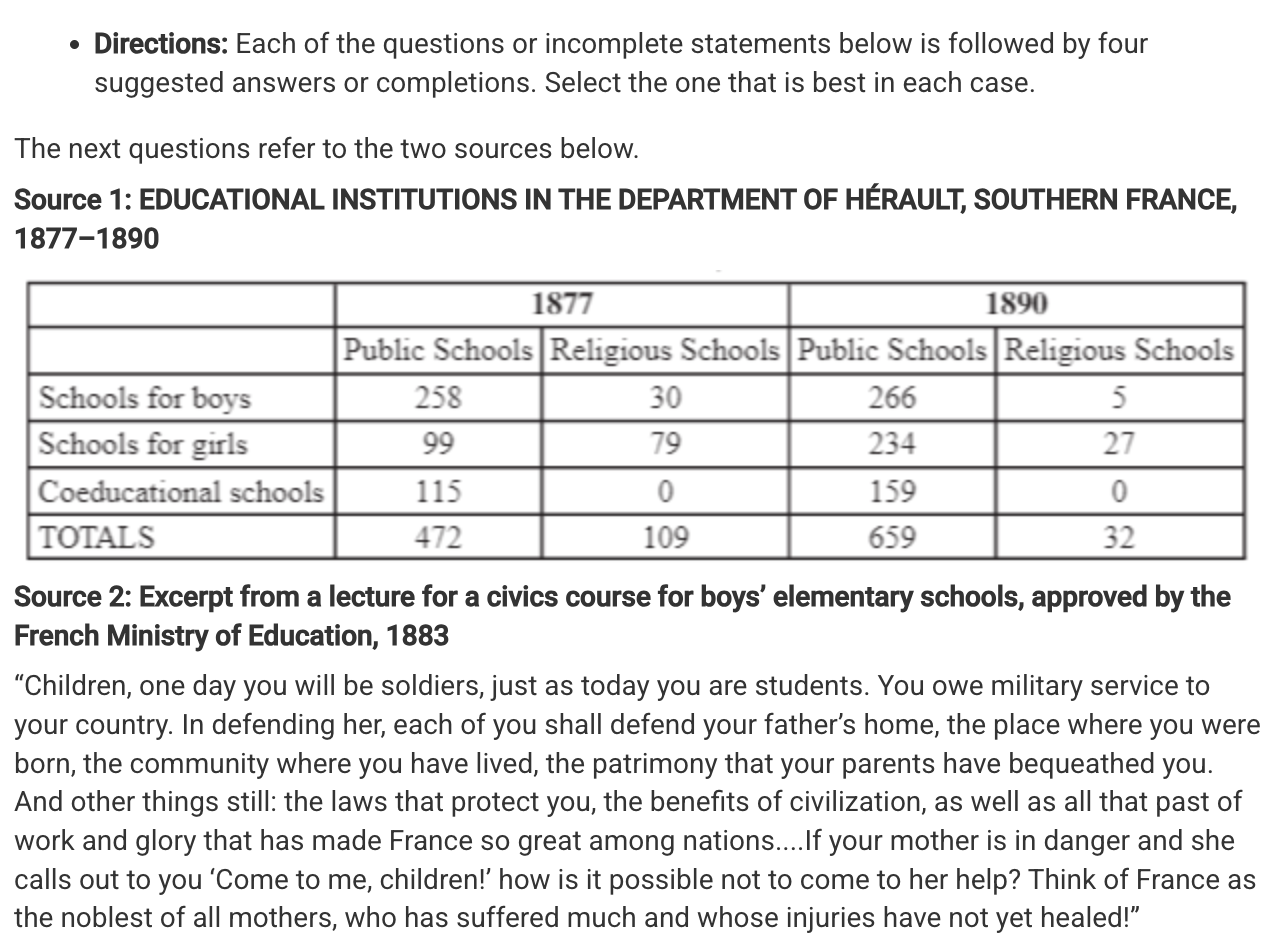
The events alluded to in the last two sentences of Source 2 are most directly related to which of the following?
A) The final defeat of Napoleon Bonaparte
B) The unification of Italy
C) The unification of Germany
D) The continued expansion of the British Empire
C) The unification of Germany

In 1881 and 1882, the French government passed laws making primary education free and compulsory for all children in France. Based on the data in Source 1, all of the following likely influenced French legislators in passing the laws EXCEPT a concern that
A) many children were not receiving any primary education
B) educational opportunities for girls were lagging behind educational opportunities for boys
C) supporting a large number of small schools was economically inefficient
D) religious schools had become too prominent a part of the educational system
C) supporting a large number of small schools was economically inefficient
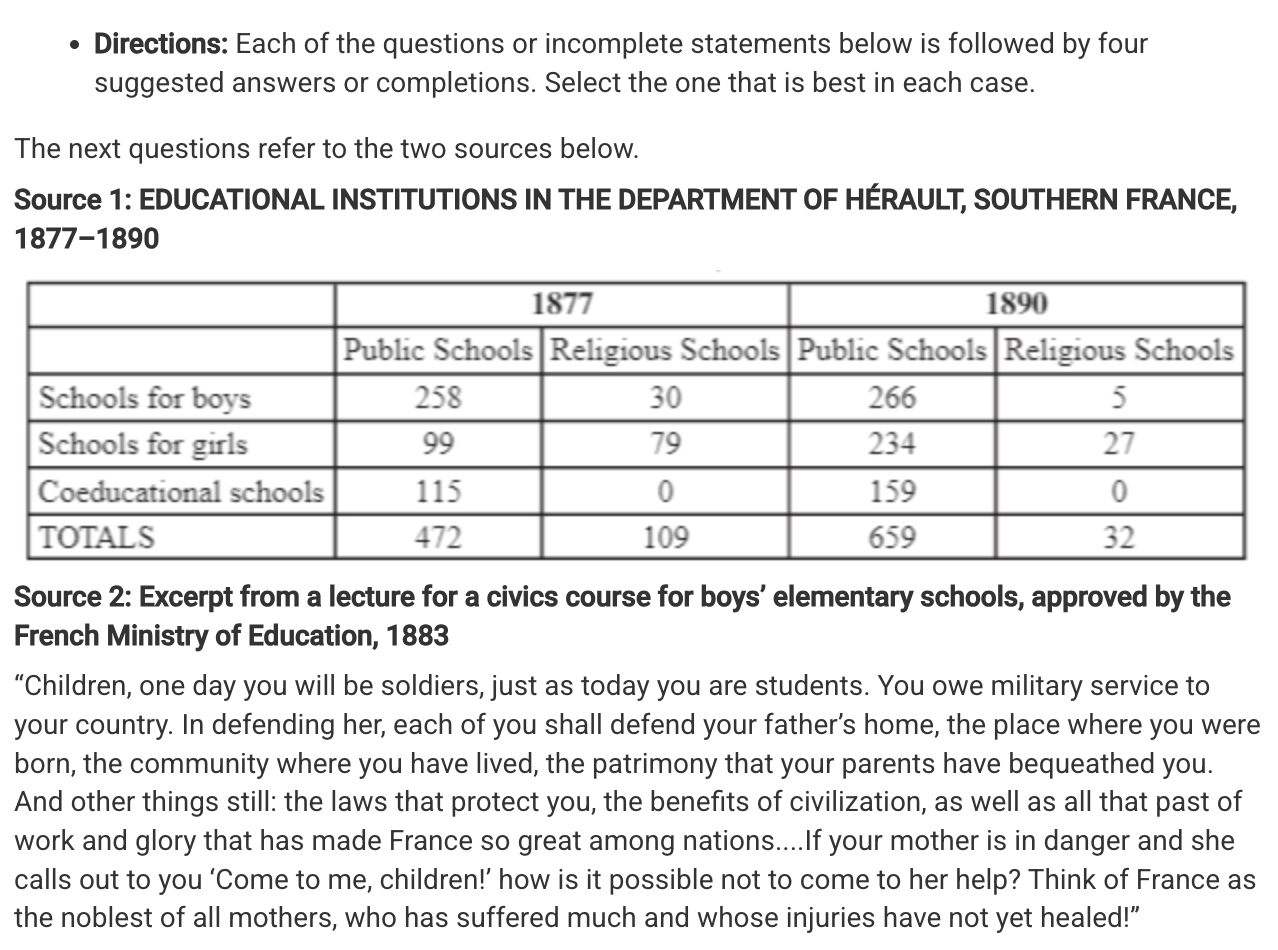
The two sources together best support which of the following statements about late-nineteenth-century European governments and public education?
A) Governments used the expansion of public education as an opportunity to promote nationalist sentiment.
B) Governments viewed providing free compulsory education as a means of containing the spread of revolutionary ideologies such as socialism and anarchism.
C) Governments used student performance in public schools to identify potential army recruits.
D) Governments viewed education as an effective means of reinforcing family ties.
A) Governments used the expansion of public education as an opportunity to promote nationalist sentiment.
The next questions refer to the passage below.
“Assume, O men of the German lands, that ancient spirit of yours with which you so often confounded and terrified the Romans and turn your eyes to the frontiers of Germany; collect her torn and broken territories. Let us be ashamed, ashamed I say, to have placed upon our nation the yoke of slavery. . . . O free and powerful people, O noble and valiant race. . . . To such an extent are we corrupted by Italian sensuality and by fierce cruelty in extracting filthy profit that it would have been far more holy and reverent for us to practice that rude and rustic life of old, living within the bounds of self-control, than to have imported the paraphernalia of sensuality and greed which are never sated, and to have adopted foreign customs.”
Conrad Celtis, oration delivered at the University of Ingolstadt, 1492
Which of the following groups in the nineteenth century would most likely have agreed with the sentiments in the passage?
A) Industrial capitalists
B) Radical anarchists
C) Romantic nationalists
D) Utopian socialists
C) Romantic nationalists
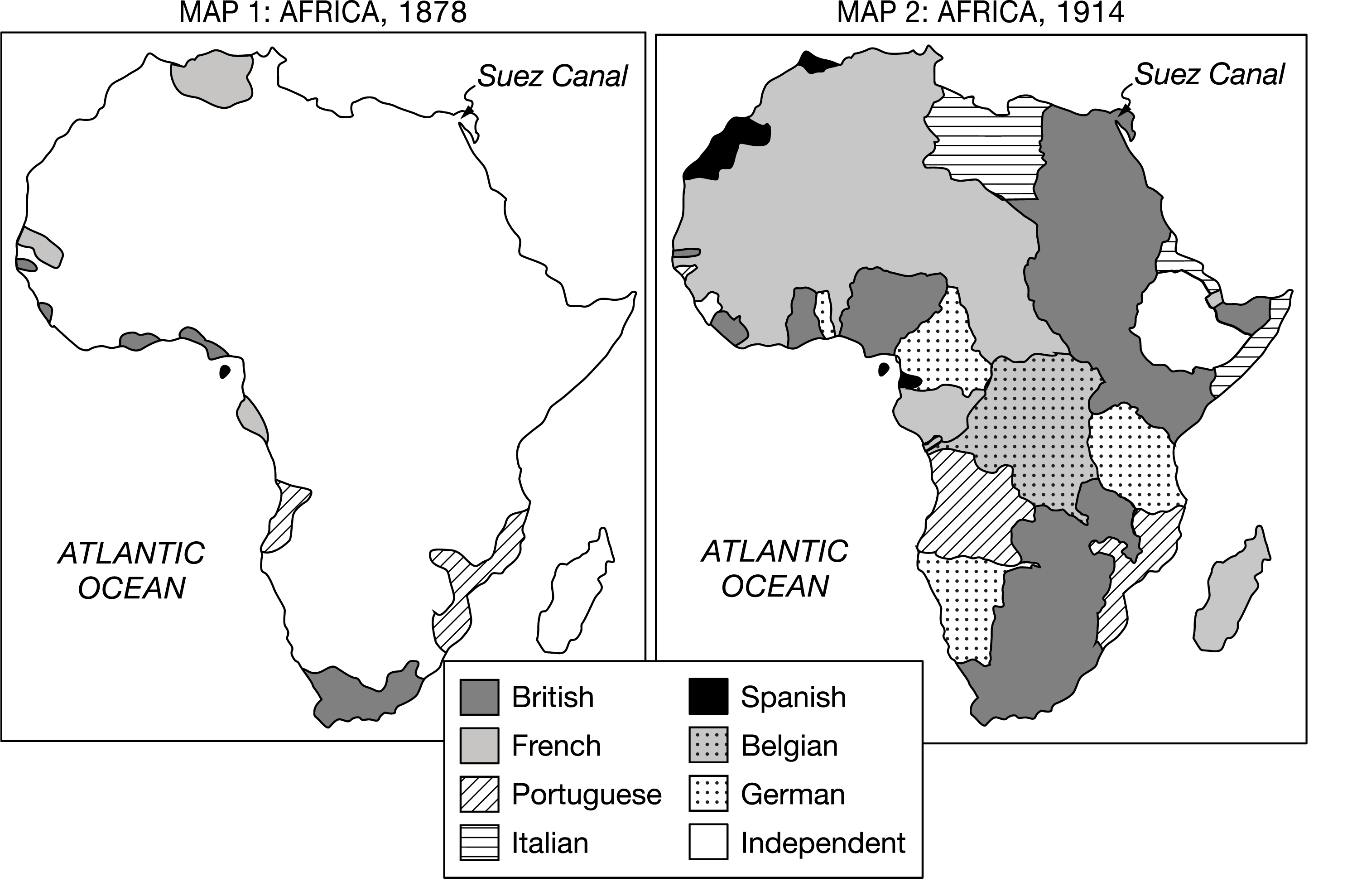
Which of the following was a major factor contributing to the changes shown on the maps?
A) The declining power of the Ottoman Empire
B) The loss of European empires in the Americas
C) Increasing nationalism in Africa
D) European advances in medicine and military technology
D) European advances in medicine and military technology
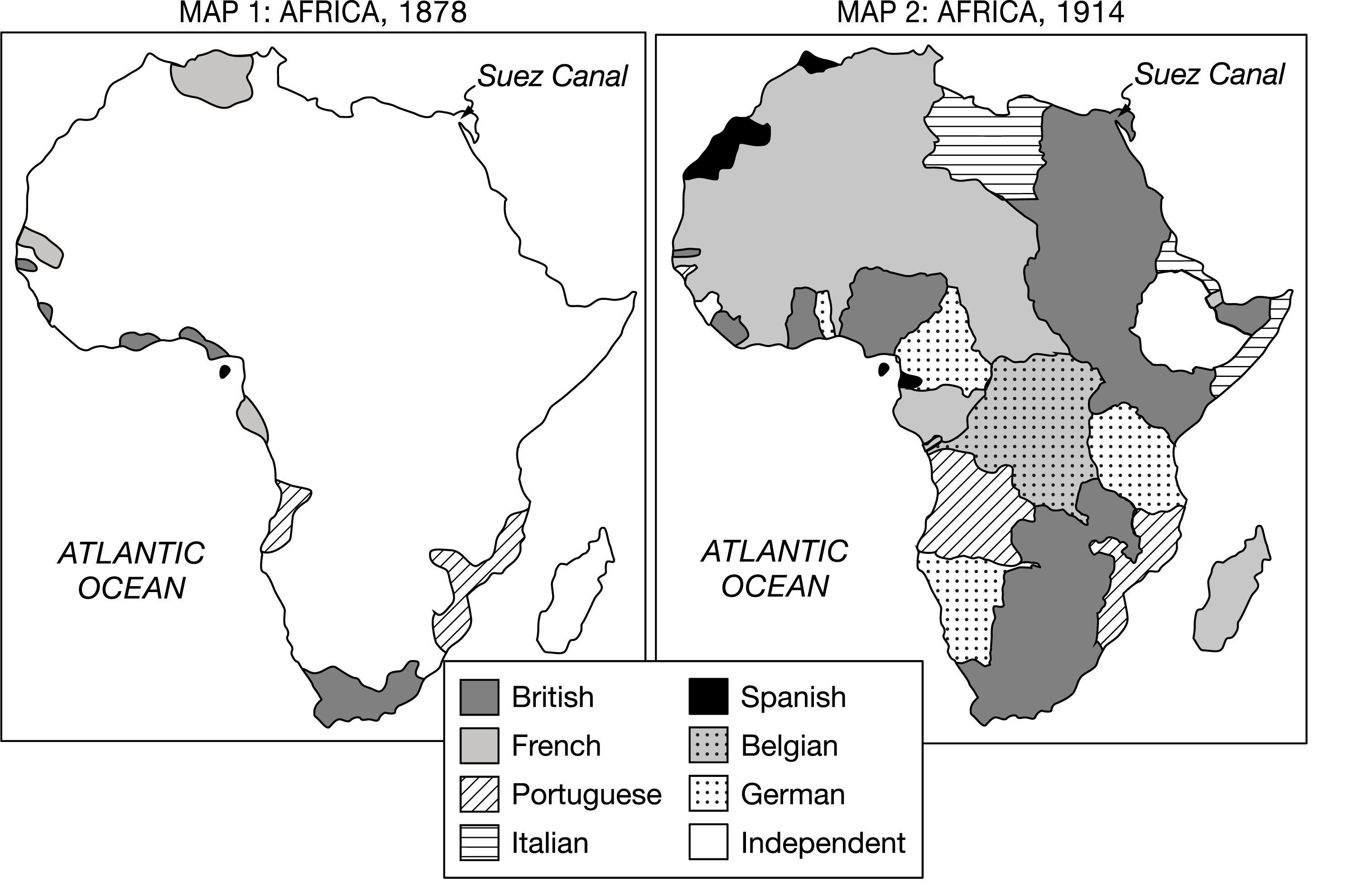
Which of the following was the most significant motivation for European governments to undertake the territorial acquisitions shown on the maps?
A) The desire to secure sources of raw materials and strategic positions
B) The desire to spread democratic forms of government
C) The desire to expand the slave trade
D) The desire to spread Christianity
A) The desire to secure sources of raw materials and strategic positions
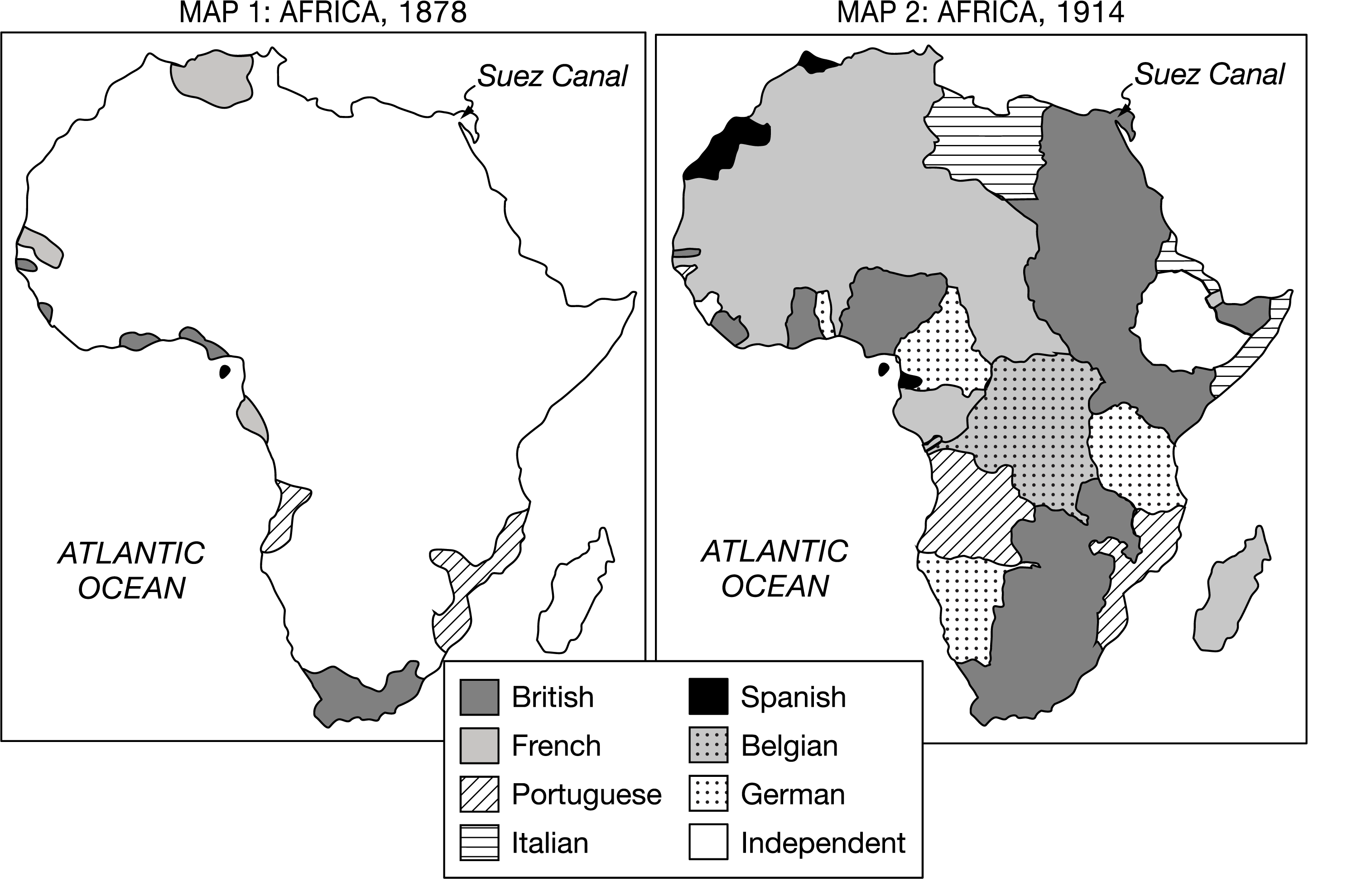
The process shown on the maps had which of the following effects on European politics in the period?
A) It led to a powerful backlash against colonialism among newly enfranchised working-class voters.
B) It destabilized the governments of many European countries that struggled to meet the costs of their new colonies.
C) It increased tensions among rival European powers by creating another venue for international competition.
D) It provided a means for European governments to lessen political radicalism by deporting dissidents to their colonies.
C) It increased tensions among rival European powers by creating another venue for international competition.
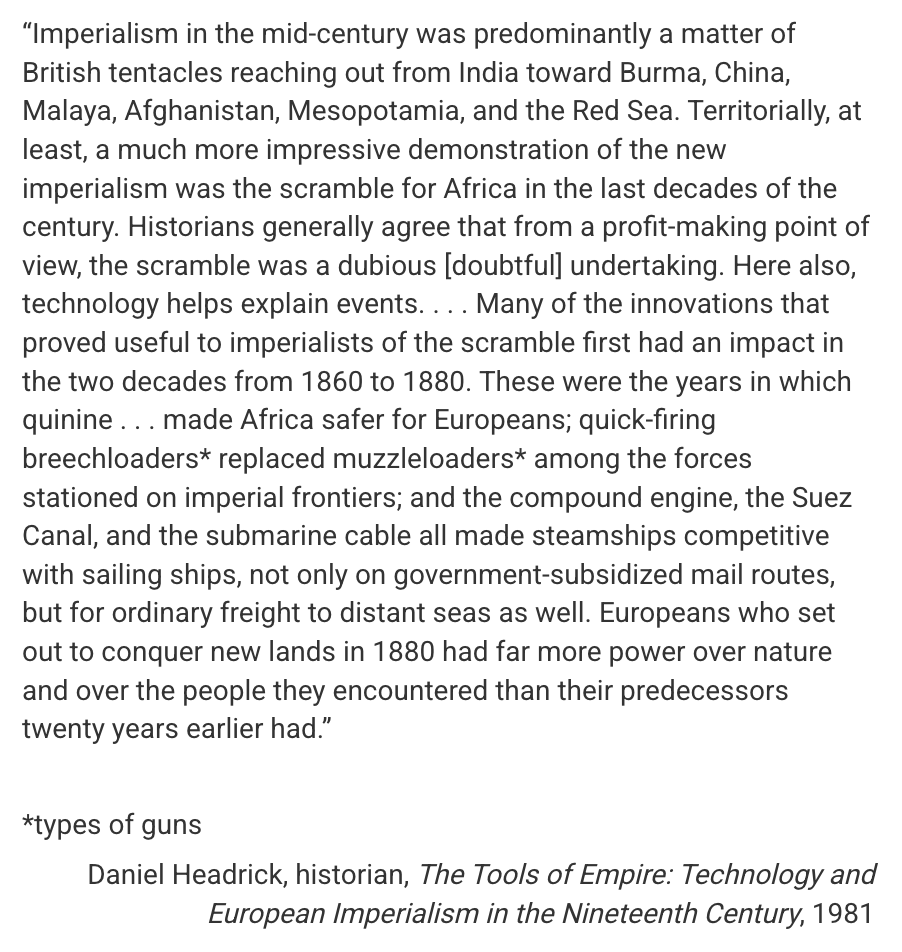
In your response, be sure to address all parts of the question. Use complete sentences; an outline or bulleted list alone is not acceptable.
a) Identify one piece of evidence the author uses to support his argument regarding how technology facilitated the rapid conquest of Africa.
b) Identify one factor in addition to the changes mentioned by the author that enabled the European colonization of Africa in the late nineteenth century.
c) Explain one way in which the technological developments described by the author affected Europeans within Europe during the late nineteenth century.
